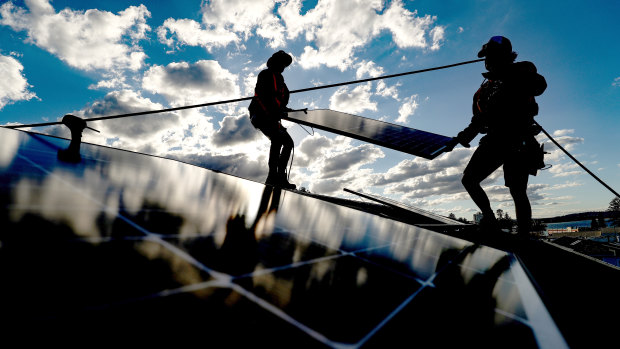Rising electricity costs are reducing the payback periods for the cost of solar panels and their installation to be fully recouped by savings on electricity bills.
Accurassi, a fintech company that estimates potential savings for households looking to install solar, illustrates the savings by sharing an estimate it did recently for a large home with a pool in Sydney’s Frenchs Forest.
Higher electricity prices shorten the time it takes to recoup the upfront costs of solar.Credit:Bloomberg
The recommendation was that the household should install a 10.85KW solar system, based on its annual electricity bill of $3600.
A variety of government incentives are available to homeowners to offset the cost of a solar system, which can include partial rebates on the solar set-up costs and low-interest loans.
The cost of the system proposed for the Frenchs Forest house – including solar panels, inverters (for converting DC electricity to AC) and installation – is about $13,000 after government rebates.
At current retail electricity prices, the household would save about 85 per cent on its electricity bill, or just over $3000 a year, by installing solar. That is a payback period of just over four years.
Accurassi founder Ross Sharman says payback periods for solar installations have shortened to about four years, from five or six years a few years ago, mainly because of higher electricity prices.
He expects the payback period will continue to shorten as electricity prices march higher, due to energy policy uncertainty and the early retirement of coal-fired power stations.
Whether solar stacks up for households depends on their tariffs and electricity consumption, including patterns of use and how much electricity prices rise.
Ben Hutt, chief executive of Evergen, which provides software to optimise solar battery systems, says higher electricity prices can improve the economics of adding not only solar panels but battery storage as well.
He says a battery can be particularly worthwhile for households with higher-than-average energy usage, or a large solar power system.
Batteries come into their own when a house is unoccupied during the day, and where, without a battery, solar power generated during that period is wasted, Hutt says.
Even when electricity is being sold to the grid during daylight hours, the solar feed-in tariff – how much is paid to you through selling excess electricity to the grid – can be low, he says.
Hutt says batteries generally cost between $8000 to $15,000 to install, depending on their capacity, quality and reliability. They typically have to be replaced after about 12 years, whereas solar panels usually last more than 20 years, he says.
Adding a battery usually means all electricity is coming from solar, with no electricity bill, though the payback period is longer than for solar-only systems.
Many people do not have the savings to pay for a solar system. However, lenders offer green loans and fintechs have buy now pay later schemes that can be paid off in instalments. Many energy retailers also offer loans to their customers.
Daniel Foggo, chief executive of lender Plenti, which offers green loans among its product offerings, says installing solar is a proven way to combat rising electricity bills. With wholesale electricity prices going through the roof, the return on investment for purchasing solar has never been better, he says.
Plenti financed $151 million in renewable energy loans in the 12 months to June 30, up 54 per cent from the previous financial year.
- Advice given in this article is general in nature and is not intended to influence readers’ decisions about investing or financial products. They should always seek their own professional advice that takes into account their own personal circumstances before making any financial decisions.
Most Viewed in Money
From our partners
Source: Read Full Article
-
One-Time Virginia Stimulus Check Coming Next Week: See If You Qualify
-
Beware unregulated ‘quick fix’ pay advances
-
European Economic News Preview: Bank Of England Set To Hold Rate
-
RM Plc Posts Prelim. FY22 Pre-Tax Loss; Annual Revenue Climbs
-
The two wildcards that could decide what happens next to interest rates


